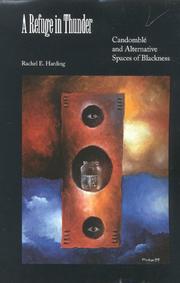| Listing 1 - 4 of 4 |
Sort by
|
Periodical
Abstract | Keywords | Export | Availability | Bookmark
 Loading...
Loading...Choose an application
- Reference Manager
- EndNote
- RefWorks (Direct export to RefWorks)
human being --- religion and society --- economics --- management and business --- art --- culture and identity
Book
ISBN: 1501757989 1609090268 087580442X Year: 2011 Publisher: DeKalb, Illinois : NIU Press,
Abstract | Keywords | Export | Availability | Bookmark
 Loading...
Loading...Choose an application
- Reference Manager
- EndNote
- RefWorks (Direct export to RefWorks)
The Enlightenment privileged vision as the principle means of understanding the world, but the eighteenth-century Russian preoccupation with sight was not merely a Western import. In his masterful study, Levitt shows the visual to have had deep indigenous roots in Russian Orthodox culture and theology, arguing that the visual played a crucial role in the formation of early modern Russian culture and identity.Levitt traces the early modern Russian quest for visibility from jubilant self-discovery, to serious reflexivity, to anxiety and crisis. The book examines verbal constructs of sight—in poetry, drama, philosophy, theology, essay, memoir—that provide evidence for understanding the special character of vision of the epoch. Levitt's groundbreaking work represents both a new reading of various central and lesser known texts and a broader revisualization of Russian eighteenth-century culture.Works that have considered the intersections of Russian literature and the visual in recent years have dealt almost exclusively with the modern period or with icons. The Visual Dominant in Eighteenth-Century Russia is an important addition to the scholarship and will be of major interest to scholars and students of Russian literature, culture, and religion, and specialists on the Enlightenment.
Russian literature --- Visual perception in literature. --- Vision in literature. --- History and criticism --- indigenous roots in Russian Orthodox culture and theology, sight in eighteenth-century Russian, effects of visuals on formation of early modern Russian culture and identity, Russian quest for visibility, intersections of Russian literature and the visual.
Book
ISBN: 0520963830 9780520963832 9780520289116 0520289110 9780520289123 0520289129 Year: 2019 Publisher: Berkeley, CA : University of California Press,
Abstract | Keywords | Export | Availability | Bookmark
 Loading...
Loading...Choose an application
- Reference Manager
- EndNote
- RefWorks (Direct export to RefWorks)
In the American imagination, no figure is more central to national identity and the nation's origin story than the cowboy. Yet the Americans and Europeans who settled the U.S. West learned virtually everything they knew about ranching from the indigenous and Mexican horsemen who already inhabited the region. The charro-a skilled, elite, and landowning horseman-was an especially powerful symbol of Mexican masculinity and nationalism. After the 1930s, Mexican Americans in cities across the U.S. West embraced the figure as a way to challenge their segregation, exploitation, and marginalization from core narratives of American identity. In this definitive history, Laura R. Barraclough shows how Mexican Americans have used the charro in the service of civil rights, cultural citizenship, and place-making. Focusing on a range of U.S. cities, Charros traces the evolution of the "original cowboy" through mixed triumphs and hostile backlashes, revealing him to be a crucial agent in the production of U.S., Mexican, and border cultures, as well as a guiding force for Mexican American identity and social movements.
Charros --- Mexican Americans --- History. --- Race relations. --- border cultures. --- charros and civil rights. --- charros. --- chicano horsemen. --- chicano studies. --- cowboys and charros. --- cowboys of the american west. --- cowboys. --- cultural citizenship. --- early 20th century charros. --- indigenous charros. --- indigenous cowboys. --- mexican american culture and identity. --- mexican american horsemen. --- mexican american social movements. --- mexican charros. --- mexican cowboys. --- mexican horsemen. --- mexican masculinity. --- mexican nationalism.

ISBN: 0253337054 Year: 2000 Publisher: Bloomington / Indianapolis Indiana University Press
Abstract | Keywords | Export | Availability | Bookmark
 Loading...
Loading...Choose an application
- Reference Manager
- EndNote
- RefWorks (Direct export to RefWorks)
Candomblé (Religion) --- Candomblé (Cult) --- Blacks --- Oppression (Psychology) --- Candomblé --- Noirs --- Oppression --- History --- Race identity --- Histoire --- Identité ethnique --- 299.6*8 --- -Blacks --- -Negroes --- Ethnology --- Candomblé (Cult) --- Afro-Brazilian cults --- Godsdiensten van de zwarten in Midden- en Zuid-Amerika. Voodoo --- -Race identity --- -History --- -299.6*8 --- -Godsdiensten van de zwarten in Midden- en Zuid-Amerika. Voodoo --- 299.6*8 Godsdiensten van de zwarten in Midden- en Zuid-Amerika. Voodoo --- -Candomblé (Religion) --- Candomblé (Religion) --- Candomblé --- Identité ethnique --- Negroes --- Black persons --- Black people --- the African Diaspora --- Brazilian culture --- Afro-Brazilian culture --- culture and identity --- American culture --- Pan-America
| Listing 1 - 4 of 4 |
Sort by
|

 Search
Search Feedback
Feedback About
About Help
Help News
News